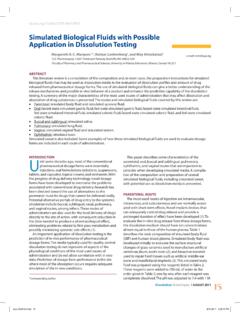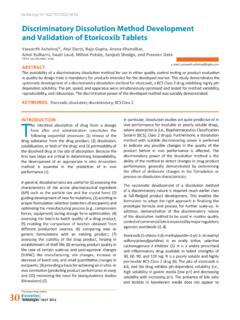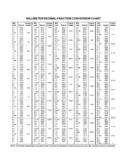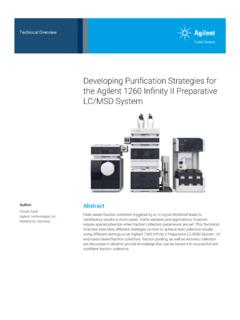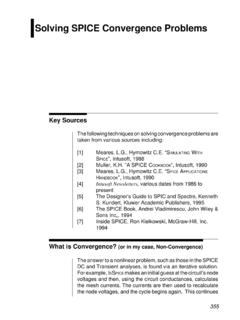Transcription of Impact of Sample Preparation on Dissolution Testing: Drug ...
1 Dissolution Technologies | NOVEMBER 200820e-mail: of Sample Preparation on Dissolution testing : drug Binding and Extractable Impurities and Their Effect on Dissolution DataVivek Joshi1,3, Jason Blodgett1, Jesmi George1, and Jeff Brinker2 1 Millipore Corp., Bioscience Division, 17 Cherry Hill Drive, Danvers, MA 019232 Distek Inc., 12 North Center Drive, North Brunswick, NJ 08902 ABSTRACTD issolution testing is a key pharmaceutical QC test required for release of oral dosage forms. It is also commonly used to predict in vivo behavior of the formulation. Filtration is a key Sample Preparation step that follows the drug Dissolution test before Sample analysis. Because of the simplicity of the filtration process, the choice of filtration devices is often ignored, leading to inaccurate and irreproducible results. This paper discusses the effects of drug binding and extractable impurities from syringe filters on Dissolution data.
2 The data presented here demonstrate that various basic and acidic drugs bind strongly to nylon membrane filters, thereby reducing drug recovery and giving an incorrect Dissolution profile. On the other hand, various drugs with different physicochemical properties do not bind to hydrophilic polytetrafluoroethylene (PTFE) syringe filters, thereby leading to quantitative drug recovery. In combination with its very low extractable profile, hydrophilic PTFE is an ideal filtration choice for Dissolution Dissolution testing is one of the most common pharmaceutical QC tests used before approval of a manufactured drug lot. According to USP and FDA guidances (1, 2), Dissolution testing is mandatory for all drugs when the active pharmaceutical ingredient (API) belongs to BCS Class II, III, or IV. Dissolution testing also helps predict the in vivo behavior of the oral dosage formulation. The test involves the Dissolution of a solid dosage form of a drug compound under controlled conditions, followed by collection and analysis of the Sample for determination of percent drug dissolved at a certain time point.
3 This implies that following Dissolution testing , filtration is a key Sample Preparation step to separate the dissolved drug from the undissolved dosage components. Filtration stops the Dissolution process, removes undissolved drug , and allows Sample analysis for amount of drug dissolved. Use of HPLC or UV-vis spectrophotometry (3) as the downstream analytical technique following Dissolution also warrants filtration before analysis because particulate impurities can affect the analysis. Due to the simplicity of this Sample Preparation technique and the fact that Sample collection and filtration are often automated, little attention is paid to this step, leading to problems downstream. Of the various filtration formats available, syringe filters are most commonly used for Sample filtration after a Dissolution test. The two main issues with syringe filters that can affect the downstream analysis are analyte binding to filters and the presence of extractable impurities from the syringe filters.
4 drug binding to syringe filters is well known (4) and affects downstream analysis. As the drug binds to a syringe filter, the concentration of drug in solution decreases, which affects the analysis and thereby affects the Dissolution profile. Extractables, on the other hand, are soluble impurities that elute from the filter and can also affect the data. This article presents data on the effects of analyte and membrane type on the drug binding characteristics of different syringe filters. The analysis of extractables from various syringe filters shows that pre-rinsing reduces the level of extractable impurities. In summary, this manuscript provides a rationale for choice of syringe filters following Dissolution AND METHODSA cetaminophen (Cat # 1003009), ranitidine (Cat # 1598405), loratadine (Cat # 1370270), and ibuprofen (Cat # 1335508) reference standards were obtained from the United States Pharmacopeia (Rockville, MD).
5 Over-the-counter oral dosage forms of acetaminophen ( Tylenol Arthritis Relief ), ranitidine (Xantac 75), loratadine (Claritin 24 Hr), and ibuprofen were obtained from a local pharmacy. All other chemicals were HPLC or ACS grade and were obtained from Sigma-Aldrich (St. Louis, MO) or Fisher Scientific (Pittsburgh, PA). Dissolution testing of drugs was carried out using the Evolution 6100 bathless Dissolution apparatus (Distek, North Brunswick, NJ) following USP procedures for these formulations. Table 1 gives detailed information about the 2011/14/2008 10:17:37 AM11/14/2008 10:17:37 Technologies | NOVEMBER 200821physicochemical characteristics of the analytes and their USP Dissolution tests and analysis conditions. USP Apparatus 2 (paddle, 50 rpm) was used for all of Dissolution MediaSome of the most frequently used Dissolution media, such as N HCl, M sodium acetate buffer (pH ), and M sodium phosphate buffer (pH ), were used for Dissolution studies in addition to the media specified in the USP procedures.
6 These Dissolution media were prepared according to USP protocol. Milli-Q water was used for all media Preparation and for Sample and standard FiltrationFollowing the Dissolution test, samples were filtered using three different Millipore syringe filters, hydrophilic PTFE (Cat #SLCRDZ5NK), hydrophilic polyvinylidene fluoride (PVDF) (Cat # SLHVDZ5NK), and hydrophilic nylon (Cat #SLHNDZ5NK). Various fractions of the filtrate (first, second, third, fifth, tenth milliliter, etc.) were collected and analyzed for amount of drug dissolved using a Spectramax 384 spectrophotometer (Molecular Devices, Sunnyvale, CA). Concentration of dissolved drug was calculated using appropriate calibration curves. Analysis of Syringe Filter ExtractablesExtractable analyses were carried out using the three Dissolution media mentioned earlier. A syringe filter attached to a glass syringe was filled with the extraction solvent, and after 5 min, the solution was filtered and the first and second milliliter fractions were collected.
7 These fractions were analyzed for the presence of extractables by reversed-phase HPLC using Waters Bondapak C18 column ( 300 mm, 10 m, USP Class L1). Water and acetonitrile were used as mobile phase components, and a gradient of 0 100% acetonitrile was used for elution of extractable impurities. A UV detector set at 214 nm and 254 nm was used to determine the presence of AND DISCUSSIONThe choice of Dissolution medium and deaeration of the medium (5), Dissolution method, and Sample Preparation (filtration) affect data accuracy and reproducibility, which leads to an inaccurate estimation of percent drug dissolved and alters the Dissolution profile. The choice of Dissolution method is usually dictated by the dosage form. Careful evaluation of multiple Dissolution media and media Preparation strategies helps to establish the final validated Dissolution medium for the test. However, limited attention is paid to Sample Preparation , and most often, filters available in-house are selected for the Dissolution test.
8 This can Impact data if the syringe filter shows drug binding characteristics, which reduces analyte recovery, or contributes extractable impurities to the Sample (6, 7). Inclusion of a filter bias study during method validation helps in identifying some of these problems before the method is transferred to QC labs (8).Analyte BindingAnalyte binding to a filtration device is dependent on analyte concentration (9) and the physicochemical nature of the analyte and the filter membrane. Syringe filters have limited surface area and available binding sites, and therefore, once the membrane is saturated with the analyte, drug binding diminishes significantly and quantitative drug recovery can be obtained. Figure 1 clearly shows a drug binding effect on the Dissolution of acetaminophen followed by filtration through nylon or hydrophilic PTFE syringe filters. Similarly, Figure 2 shows a drug binding effect on the Dissolution of loratadine.
9 At each time point, the first, second, and tenth milliliter of filtrate was collected and analyzed for acetaminophen concentration using spectrophotometry. When samples were filtered using a nylon syringe filter after the Dissolution test, a clear drug binding effect was seen for the first milliliter of filtrate. As filtration continued through the same filter, this effect diminished, and the second milliliter of filtrate showed much higher drug recovery. Further filtration led to complete recovery of the analyte. When the same Sample was filtered through a hydrophilic PTFE syringe filter, no drug binding was observed irrespective of the fraction of filtrate collected. Similar to Figures 1 and 2, Table 2 shows percent drug recovery data following the Dissolution test for three different drugs (acetaminophen, loratadine, and ibuprofen) using the Table 1. Physicochemical Characteristics and Dissolution Conditions for Drugs Used in Dissolution Studies DrugTypepKaDissolution Medium*Time (min)UV Analysis (nm)Acetaminophen ( Tylenol Arthritis Pain)Weakly acidic gastric fluid without enzymes240243 Loratadine (Claritin 24 Hr)Weakly N HCl 60280 Ranitidine (Xantac 75) 45314 IbuprofenAcidic Buffer pH 60221* As per USP 2111/14/2008 10:17:38 AM11/14/2008 10:17:38 AMDissolution Technologies | NOVEMBER 200824three filters mentioned above.
10 At the end of the Dissolution test, the first, second, and tenth milliliter fractions were collected and analyzed for drug concentration using spectrophotometry. This data clearly shows reduced drug recovery when using nylon filters is a result of drug binding. This strong drug -binding characteristic exhibited by nylon syringe filters is in line with what has been reported (4).To evaluate whether this drug binding effect shown by Millipore nylon syringe filters is a characteristic of the particular nylon membrane used in these filters or an Figure 1. Effect of acetaminophen binding on recovery following filtration through (A) nylon and (B) hydrophilic PTFE membrane filters. Figure 2. Effect of loratadine binding on recovery following filtration through (A) nylon and (B) hydrophilic PTFE membrane filters. Table 2. Effect of Membrane Type on Percent drug Recovery Following Dissolution Test and Spectrophotometric Analysis% Acetaminophen% Ibuprofen% LoratadineFraction collectedNylonPVDFPTFEN ylonPVDFPTFEN ylonPVDFPTFE1st mL7291 94 90 96 96 70 88972nd mL9798 94 961011001001009810th 2411/14/2008 10:18:09 AM11/14/2008 10:18:09 AMDissolution Technologies | NOVEMBER 200825 Figure 3.




